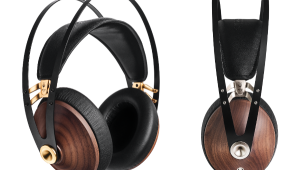Review: Fanny Wang WangBuds Page 2
Measurements
To measure the WangBuds, I used a G.R.A.S. 43AG ear/cheek simulator, a Clio FW audio analyzer, a laptop computer running TrueRTA software with an M-Audio MobilePre USB audio interface, and the Musical Fidelity V-Can headphone amplifier. Measurements were calibrated for ear entrance point (EEP), i.e., the entrance to the ear canal, which is approximately where the WangBuds drivers will sit. With IEMs, I use only the G.R.A.S. RA0045 coupler, not the full ear/cheek simulator, but the WangBuds wouldn’t fit into the coupler. I experimented with the position of the earpieces by moving them around on the ear/cheek simulator, tried using the simulator’s clamping mechanism, and as you’ll see, even tried pushing the earpieces into the simulator with my finger. Let it suffice to say that the WangBuds present significant challenges for measurement, so please take these results as ballpark, not absolute, figures.
The only way I could get something that looked like a normal headphone frequency response was by pushing the WangBud into the sim with my finger. The result was a hugely bass-heavy balance, with slight peaks at 2 and 8 kHz. I’ve added a graph here that compares the FR result with my finger and with the sim’s clamping mechanism (which provides a substantial amount of pressure). As you can see, with just the clamp, the response peaks at 630 Hz and below that, it plummets. This corresponds well with what our testers heard. Adding 70 ohms output impedance to the V-Can’s 5-ohm output impedance to simulate the effects of using a typical low-quality headphone amp tilted the balance even more to the bass, bumping the bottom end up by +1.5 to +2 dB, and reducing treble by -2 to -4 dB.
Except for a weird peak at 3.7 kHz (which showed up in repeated measurements), total harmonic distortion (THD) at 100 dBA is practically non-existent at all frequencies. Using the sim’s clamp mechanism, I got about -10 dB of isolation from 1.3 to 4 kHz, but effectively none at other frequencies.
Measured impedance drops from a high of 33 ohms in the bass to a low of 6.5 ohms at 15 kHz, which is weird for a headphone but understandable given the unusual driver arrangement. Average sensitivity with a 1 mW signal at 16 ohms rated impedance is 102.2 dB from 300 Hz to 6 kHz, with the earbud pushed in with my finger.
Bottom line
We’re intrigued by the acoustical design of the WangBuds, but saddened by the fact that it uses these awful, sucky, useless oblong silicon tips that prevent the WangBuds from delivering what the measurements prove they’re capable of. We’d love to hear the same design refitted to use standard silicon tips.






















































